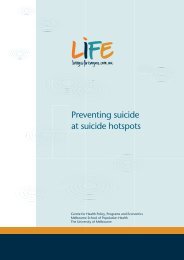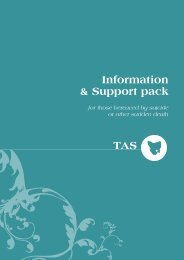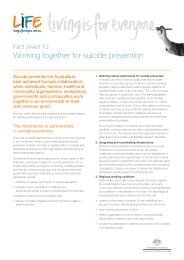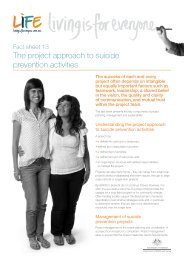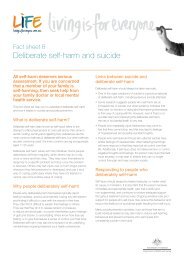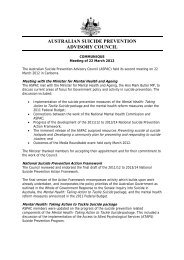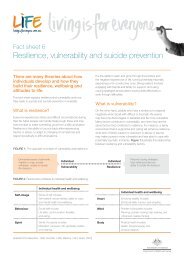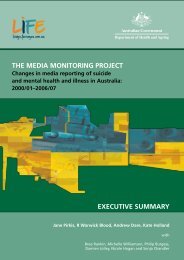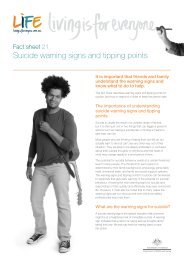SUICIDE in RURAL & REMOTE AREAS of AUSTRALIA - Living is for ...
SUICIDE in RURAL & REMOTE AREAS of AUSTRALIA - Living is for ...
SUICIDE in RURAL & REMOTE AREAS of AUSTRALIA - Living is for ...
Create successful ePaper yourself
Turn your PDF publications into a flip-book with our unique Google optimized e-Paper software.
20<br />
Suicide <strong>in</strong> rural and remote areas <strong>of</strong> Australia<br />
Rationale <strong>for</strong> a relationship<br />
between contextual factors and<br />
suicide <strong>in</strong> Australia<br />
As documented <strong>in</strong> Chapter One, there are vast<br />
differences <strong>in</strong> the social, economic and cultural<br />
backgrounds <strong>of</strong> metropolitan and remote areas<br />
<strong>of</strong> Australia. Various researchers have argued that<br />
these differences may hold an <strong>in</strong>fl uence on the<br />
patterns and trends <strong>of</strong> suicide (Judd et al, 2006a;<br />
Judd et al, 2006b; Alston, 2010; Alston & Kent,<br />
2008; Hirsch, 2006). However, while the possible<br />
relevance <strong>of</strong> “place-based” factors (e.g. contextual<br />
economic, social, and cultural factors) on suicide<br />
<strong>in</strong> metropolitan and remote areas has been<br />
recogn<strong>is</strong>ed, these have not been systematically<br />
<strong>in</strong>vestigated <strong>in</strong> Australia.<br />
The prem<strong>is</strong>e <strong>for</strong> a possible relationship between<br />
contextual factors and suicide <strong>is</strong> based on a long<br />
h<strong>is</strong>tory <strong>of</strong> research <strong>in</strong> suicidology (e.g., Durkheim,<br />
1897/1951). Durkheim (1897/1951) argued that<br />
suicide <strong>in</strong> a society refl ected the cultural, social<br />
and economic environments <strong>in</strong> which it was<br />
embedded. In the book Le Suicide (1897/1951),<br />
he suggested that suicide was dependent on two<br />
l<strong>in</strong>ked <strong>for</strong>ces: social <strong>in</strong>tegration (the degree to<br />
which persons have shared beliefs and sentiments<br />
and a sense <strong>of</strong> devotion to common goals) and<br />
social regulation (the mechan<strong>is</strong>ms through which<br />
society imposes restra<strong>in</strong>ts and limits on <strong>in</strong>dividual<br />
needs and thereby prevents variations <strong>in</strong> the<br />
suicide rate <strong>of</strong> a population) (Johnson, 1965;<br />
Morr<strong>is</strong>on, 2006). Follow<strong>in</strong>g on from th<strong>is</strong> approach,<br />
researchers from the Chicago School <strong>of</strong> Sociology<br />
developed the concept <strong>of</strong> “social d<strong>is</strong>organization”,<br />
as character<strong>is</strong>ed by the breakdown <strong>of</strong> communal<br />
<strong>in</strong>stitutions (e.g., family, church, local government)<br />
and communal relationships (Jensen, 2003).<br />
“Social d<strong>is</strong>organization” has been used to expla<strong>in</strong><br />
a number <strong>of</strong> “deviant” behaviours and suicide<br />
(Jensen, 2003).<br />
Subsequent studies have identifi ed a number <strong>of</strong><br />
population-level <strong>in</strong>fl uences on suicide. Factors<br />
traditionally associated with higher suicide <strong>in</strong> a<br />
population <strong>in</strong>clude divorce, migration, and changes <strong>in</strong><br />
employment (e.g., female labour <strong>for</strong>ce participation,<br />
unemployment, and type <strong>of</strong> employment) (Andersen<br />
et al, 2010; Blakely et al, 2003; Stack, 2000). An<br />
explanation <strong>for</strong> these relationships <strong>is</strong> that they<br />
represent the adverse <strong>in</strong>fl uence (or d<strong>is</strong>ruption)<br />
<strong>of</strong> contextual factors on normative social roles<br />
and relationships <strong>in</strong> society, which subsequently<br />
<strong>in</strong>crease the r<strong>is</strong>k <strong>of</strong> suicide.<br />
Suicide rates have also been related to trends <strong>in</strong><br />
national economies (Yang & Lester, 2001), as well<br />
as to <strong>in</strong>come and spend<strong>in</strong>g on health care (Milner<br />
et al, 2010; Neumayer, 2003; Zimmerman, 2002).<br />
Fertility and religion are usually associated with<br />
suicides rates, possibly because these re<strong>in</strong><strong>for</strong>ce<br />
social and community ties and rules (Lester & Yang,<br />
1992; Stack, 2000). As already documented <strong>in</strong> the<br />
Australian context, remote and rural areas usually<br />
have higher suicide rates than urban areas (Page<br />
& Fragar, 2002; Phillips, 2009; Page et al, 2007).<br />
Factors expla<strong>in</strong><strong>in</strong>g the higher rates <strong>of</strong> suicide <strong>in</strong><br />
remote areas may <strong>in</strong>clude rural socioeconomic<br />
decl<strong>in</strong>e, limited service availability and accessibility,<br />
rural culture, community attitudes to mental illness<br />
and help seek<strong>in</strong>g, and exposure to fi rearms (Judd et<br />
al, 2006a).<br />
GriffithBook FINAL 20/09.<strong>in</strong>dd 20<br />
15/11/12 4:28 PM





